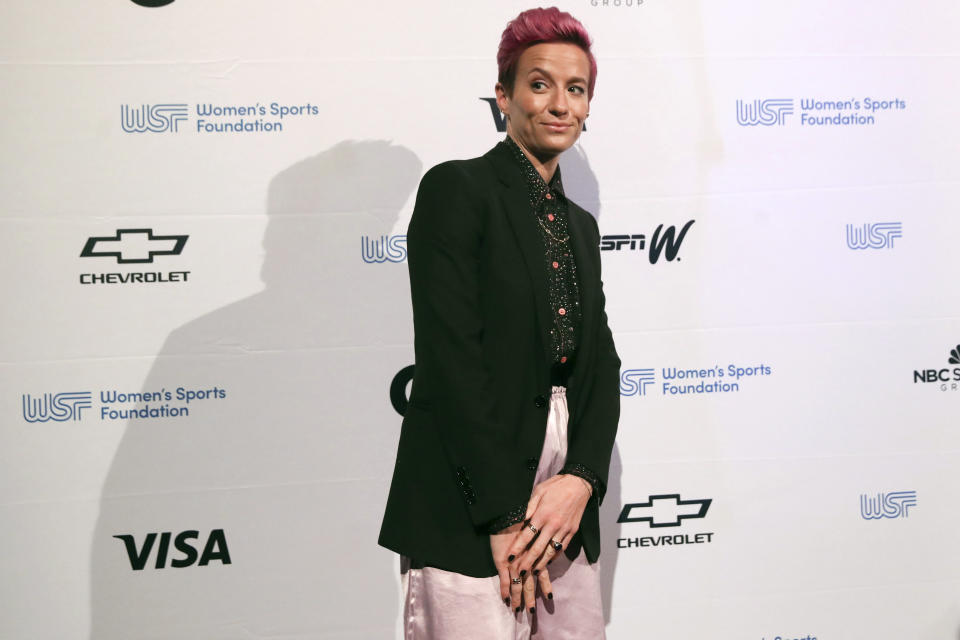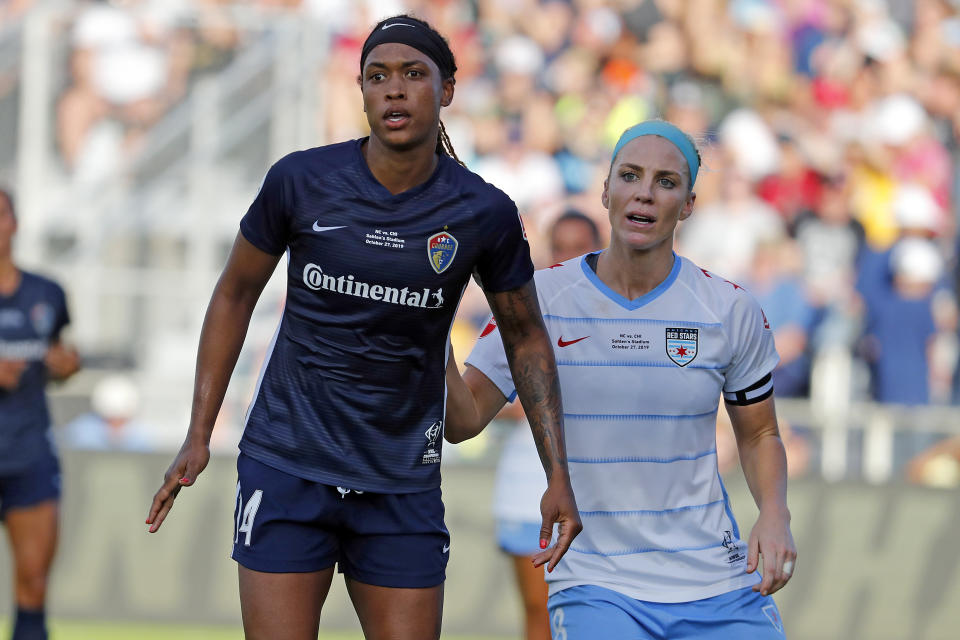'You’re not cutting me out of that upside': Rapinoe, USWNT players upset with new NWSL pay guideline

It was a landmark announcement for the National Women’s Soccer League. For the first time in the young league’s history, it was introducing a new spending mechanism called allocation money, which would allow team owners to spend big on stars.
But when members of the U.S. Women’s National team first saw the new compensation rules, something else also jumped out to them. It was a line that read: “Allocation money may not be used for Canadian or U.S. allocated players.” In other words, USWNT players who committed themselves to the NWSL since its inception can’t see a dime of the influx of cash.
Players on the USWNT quickly began messaging each other, raising questions about the new rules, which the league announced on Nov. 1.
“Immediately people were like, ‘Um, you’re telling me we're opening up the money but I’m stuck?’” Megan Rapinoe tells Yahoo Sports. “‘We’re gonna be here for seven years, and then you’re gonna bring in whoever for $200K and I’m gonna be making what I'm making now?’ It's just not fair.”
It’s not that Rapinoe or players on the USWNT don’t support the changes, which should help the NWSL compete against leagues in Europe that have seen growing attendance, sponsorships and professionalism in recent years. Overall, USWNT players are glad that the NWSL has agreed to invest more in its players — but it shouldn’t be to the exclusion of USWNT players.
“On one hand, do we need to pay players more? Yes,” Rapinoe says. “Do we need to have the ability to get a Dzsenifer Marozsan, Eugenie Le Sommer, Lucy Bronze, Wendie Renard, and these types of players here? Yes, 100%. But you’re not cutting me out of that upside.
“There has to be some sort of structure where teams are incentivized to pay their national team players or else that player gets to choose where they want to go,” Rapinoe adds. “I don’t know what the best option is, but I’ll tell you what the best option is not: to do all of this behind closed doors, to not bring the national team players in at all. The best way is not to drop this on us and then, in the middle of the text, slip in that all national team players are excluded.
“I’m sorry, that’s just so disrespectful and such a slap in the face to everything that we do to grow this sport in this country.”

The new compensation structure, which was approved by the NWSL board of owners for the 2020 season, will allow teams to purchase up to $300,000 in allocation money to pay players above the maximum salary of $50,000. Additionally, allocation money can be traded, so teams could conceivably spend several hundred thousand dollars on a single star player if they wanted.
But USWNT players, who are prohibited from receiving allocation money under the new rules, will be stuck at a maximum salary of $77,500, with some USWNT players earning $72,500. That salary is paid by the U.S. Soccer Federation for USWNT players to be assigned NWSL teams as set by their collective bargaining agreement, which expires in 2021 and is currently the subject of a wage discrimination lawsuit.
As part of the CBA, the players earning separate national team salaries from U.S. Soccer are required to play in the NWSL — a deal USWNT players agreed to because they wanted a domestic league to grow and thrive.
In some cases, USWNT players committed themselves to the NWSL even though they could’ve earned more elsewhere. Rapinoe, for instance, earned the equivalent of around $170,000 per year in Lyon, and her club salary dropped to a fraction of that when the NWSL first launched and she left Lyon for the Seattle Reign.
In drafting the new rules, the NWSL competition committee set out to ensure the league would attract and retain certain types of players it struggled to get ahold of: big-name internationals who could earn huge paychecks in Europe, quality domestic players on the cusp of the USWNT, and draft picks who can often earn more going overseas because of the NWSL’s low $20,000 minimum salary.
While the NWSL Players Association was in dialogue with the NWSL competition committee as changes were under consideration, and offered feedback that led to a new provision requiring year-round housing, the USWNT Players Association was not kept in the loop.
“When it was announced to the press, we had only heard what the rules were around allocation money a few hours prior,” says USWNT PA director Becca Roux. “These rules are extremely positive for the league. I just wish our right, per the CBA, to have a seat at the table while they're developing these types of changes had been honored.
“We have already requested to get a copy of the rules, and we have asked as well to have a call to discuss the rules, and one of the things we will discuss is the restriction,” she adds.
[ Follow Yahoo Soccer on Twitter and Facebook ]
Though the USWNT PA is still waiting for a response from the NWSL and U.S. Soccer as of Sunday night, she says, the union will likely be asking for removal of the allocation money restrictions on USWNT players.
“There is no team, no group of players, who is more committed to their sport than we are — stop cutting us out of the conversation,” Rapinoe says. “We have a lot of really good ideas, we all want to be here, we all want to play in the league, we all want it to be better, we all want everyone else to be paid more, we all want there to be more money to bring better players in. So let's have the conversation.”
The NWSL may soon find itself in a position where USWNT players are no longer guaranteed to stick around, and different mechanisms designed to keep those players will become a necessity.
Right now, USWNT players on a federation contract are only allowed to skip the NWSL for a single season. But the USWNT’s current CBA expires in 2021, and multiple sources have indicated to Yahoo Sports that it is unlikely NWSL salaries or requirements will be part of the next CBA, especially since U.S. Soccer is expected to step away as the NWSL's operator at the end of the year.
On one hand, that would mean USWNT players could no longer be yanked way from their club teams outside FIFA dates and they would become direct employees of NWSL teams. On the other hand, NWSL teams would have to put up their own money to sign such high-caliber players.
Whether USWNT players are locked into playing in the NWSL or not, they are unquestionably the stars that have driven the league forward and will continue to do so. They are the players that fans are often attending games to see, and the players who tend to help teams win trophies.
But now, with allocation money being spent on only non-USWNT players, the new rules could create an imbalance where the most-talented and highest-drawing player on a given team isn’t compensated according to her value.
“We’re the best players on most of our teams and I think we should be compensated as such,” Rapinoe says. “It’s not fair that players on my team are making more than me. I’m sorry, it isn’t. Sports are a meritocracy in that way, and we need to find a way to appropriately compensate our best and brightest and leave space to pay all the other players so much more because those players are the foundation of the league with us.”
Caitlin Murray is a contributor to Yahoo Sports and her book about the U.S. women’s national team, The National Team: The Inside Story of the Women Who Changed Soccer, is out now. Follow her on Twitter @caitlinmurr.
More from Yahoo Sports: